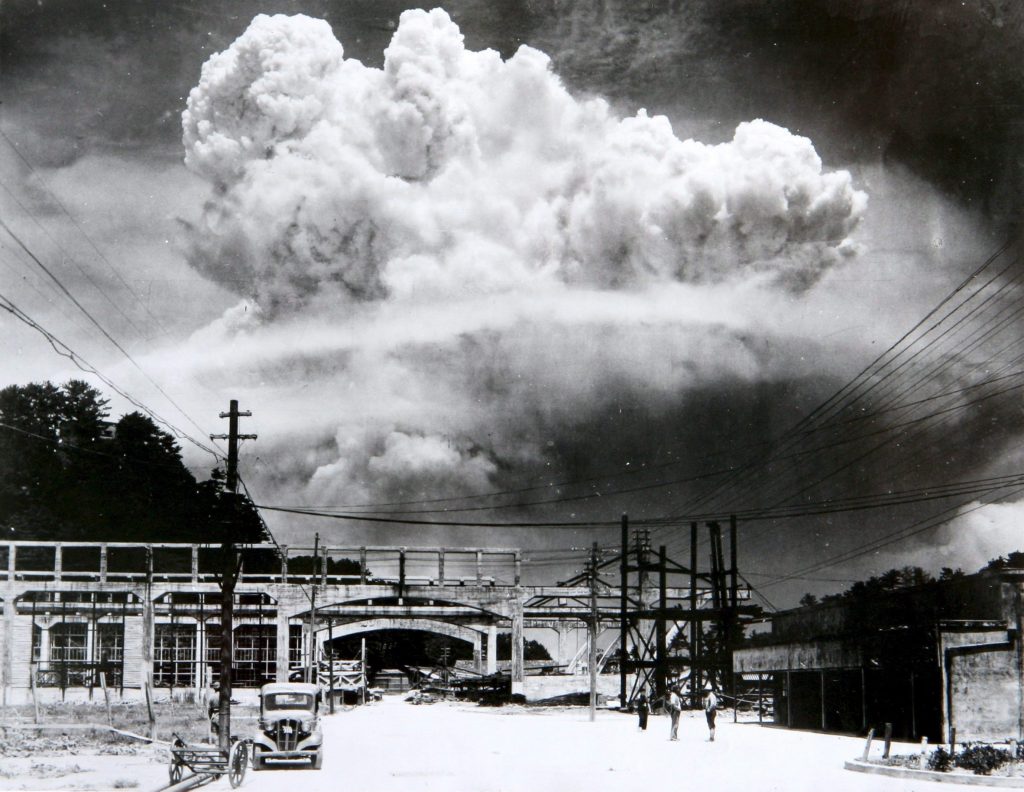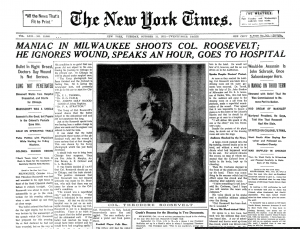August of 1945 marked grim days of apprehension for many cities across Japan. The Japanese people were running dangerously low on resources and manpower to continue the conflict of World War II, while the United States had steadily increased the frequency of air raids on the Japanese mainland islands. In spite of being desperate, the Japanese people couldn’t admit surrender without assurance that their emperor, whom they regarded as a godlike idol, would not be disposed of—a condition that the Americans would not entertain. Meanwhile, the United States public was sour on the idea of sending additional troops into the Pacific for what would surely be a costly land invasion of the Japanese mainland.1 The ongoing aerial raid campaign, which would claim hundreds of thousands of Japanese lives, wounding countless others, and decimating if not entirely leveling cities, would not be enough to provoke an unconditional surrender on behalf of the Japanese people.2 Alas, President Truman, as well as the American people, were in search of resolution to their Pacific conflict. Japan and the whole world alike were aghast as the U.S. unleashed the first ever atomic bombs on the Japanese cities Hiroshima and Nagasaki on the 6th and 8th of August, respectively. But, perhaps, no one would be quite as appalled as Tsutomu Yamaguchi, who would endure and witness both atomic demonstrations.
In early June, Tsutomu was called away from his home in Nagasaki to help oversee the design and manufacture of battleships and fuel transports at a shipyard in Hiroshima. Due to the U.S. naval fleet blockading the region, the Japanese were forced to produce half-sized vessels. It wasn’t until being separated from his wife and 3-year-old son that Tsutomu experienced his first major encounter with the encroaching enemy. While stationed in the Hiroshima shipyard dormitory, he observed the vast and overwhelming hundreds of planes enlisted in the strategic raids against Japan. However, the raid would shy in comparison to what was to come.3
On August 5, the day before Hiroshima was to be bombed, the business objectives at the Mitsubishi Shipyard in Hiroshima were complete; however, damage to Japanese infrastructure back in Nagasaki delayed the young worker’s return. It wasn’t until the following day that Tsutomu was given the go ahead to come back home. On his way to the train station on the edge of town, he realized he had left his travel stamp and ID behind. Forced to return to retrieve those items, Tsutomu headed back to his camp. While passing by a shooting gallery, he heard the faint roar of a distant B-29 bomber. Tsutomu looked to the clouds, but caught no glances of the aircraft. Instead, he saw a slowly falling pair of parachutes. Boom! There was a blinding flash followed by a wave of immense heat. He was hurled into a neighboring potato patch. When he regained consciousness, he found his hair fused into his scalp and severe burns seared along his left arm, upper torso, and face.4 Though many other victims would be encountered throughout Tsutomu’s journey home—baring injuries that varied from burns and abrasions to lacerations and radiation exposure—countless others would die in the infernos and blazes that chained through any remains of the sprawling metropolis. Tsutomu Yamaguchi managed to escape the fallout and evacuate on a train bound for Nagasaki. There he was reunited with his family and received treatment from a generous acquaintance from his past. But he was not in the clear just yet.5

During his business trip, the Japanese began relocating the residents of Nagasaki to the rural outskirts. Strangely enough, Tsutomu and his family were moved to the most dangerous part, just outside the Nagasaki Shipyard. Mere minutes before the second atomic bomb was dropped, with little options at his disposal, Tsutomu reported in for work. His boss called him in to inquire about the events that took place; Tsutomu spoke of a single bomb causing tremendous devastation. During the discussion, a familiar flash pierced their retinas. Yet again, he’d come face to face with the atomic adversary that was wreaking havoc on the Japanese people. But his fight wouldn’t be stopped there.6
He and his family survived the ordeal and after the war, Tsutomu made use of his license to teach English at a junior high school. After ten years of teaching, he returned to Mitsubishi Shipyard and retired. With time, Tsutomu would officially become recognized, by both the United States and Japan, as having survived both atomic bombs, earning him the title “nijū hibakusha” (or twice-bombed man).7 He would go on to use his recognition and experience to advocate for the abolishing of nuclear arsenals. Tsutomu realized that nuclear arms wouldn’t lessen the price humanity pays for its wars; to the contrary, it would merely accelerate and facilitate its own destruction.8

- Henry Lewis Stimson, “The decision to use the atomic bomb,” Harper’s Magazine (February, 1947): 97-107, www.harpers.org/archive/1947/02/ ↵
- Jonathan Rauch, “Firebombs Over Tokyo The Atlantic,” The Atlantic 272, no., 5 (2002): 1-1, https://www.theatlantic.com/magazine/archive/2002/07/firebombs-over-tokyo/302547/. ↵
- Tsutomu Yamaguchi et al., Double A-Bomb Victim: My Life beneath the Atomic Clouds (Nagasaki Prefecture: Department of Political Science, Faculty of Education, Nagasaki University, 2013), 88-90. ↵
- Charles Pellegrind, The Last Train From Hiroshima: The Survivors Look Back (New York: Henry Holt and Company, LLC, 2010), 15-17. ↵
- Twice, directed by Hidetaka Inazuka, 2011, Netflix. www.netflix.com/title/80208212; Tsutomu Yamaguchi et al., Double A-Bomb Victim: My Life beneath the Atomic Clouds (Nagasaki Prefecture: Department of Political Science, Faculty of Education, Nagasaki University, 2013), 93-94. ↵
- Tsutomu Yamaguchi et al., Double A-Bomb Victim: My Life beneath the Atomic Clouds (Nagasaki Prefecture: Department of Political Science, Faculty of Education, Nagasaki University, 2013), 106-107. ↵
- The Associated Press, Survivor of Both A-Bombs Is Certified (Manhattan: New York Times, 2009). ↵
- Tsutomu Yamaguchi et al., Double A-Bomb Victim: My Life beneath the Atomic Clouds (Nagasaki Prefecture: Department of Political Science, Faculty of Education, Nagasaki University, 2013), 110. ↵



31 comments
Aiden Dingle
I’ve heard stories about this guy, but it’s really interesting to read exactly what happened to him. He might just be the luckiest guy to ever live, surviving both of the nuclear bombs dropped by the United States during world war 2. But, I can’t really imagine what kind of things he saw after the explosion. How much death and destruction did he see after both of those bombs and how was he able to live with himself knowing that he was one of the few people survive?
Jacqueline Mendez
Learning about the atomic bombs throughout history my entire life, I’ve never really been in favor nor against the nuclear attack. Quite frankly nowadays I wish this technology was never discovered. This article made me think and made me be against nuclear bombs. His story is very sad and eye-opening about a survivor’s point of view.
Roberto Rodriguez
That is one heck of a story, I can only imagine what it is like to survive such a traumatic experience, let alone two of them so close together! He must have felt really grateful to be alive and probably some sort of duty to tell the story of those that died from the bombs. It is really great that he got to tell his story and really make an impact on the world by turning his story of grief into a story of powerful advocacy. It is really great to know that he is recognized by both Japan and America in the end.
Mark Dominguez
A very fascinating and thorough article, I had never heard of Mr. Yamaguchi’s story prior to reading this article. It is remarkable that this man was able to survive not one, but two bombings. This must be some of the best or worst luck to have to endure two bombings, nonetheless, it is still amazing that he and his family survived.
Jesus Parker
It is crazy what humans can accomplish when they put their minds to it, one of those things was the atomic bomb. What is even crazier is how one man was able to survive not only one but two atomic bombs when those bombs jobs were to kill everything and anyone in its radius. I agree on Tsutomu’s stance of nuclear warfare and that is these weapons will surely be the end for humanity.
Sebastian Azcui
This article really impacted me. Back in high school I learned about World War II and how President Truman decided to drop the atomic bombs to the cities of Hiroshima and Nagasaki. But, I never heard or read a story from someone that was actually there and survived. I think Tsutomu Yamaguchi has a very wide perspective of how the event occurred. Its impressive to read how a survivor tells the story of how that day was. Just seeing a pair of parachutes fall from a B-29 bomber and then a massive flash of light burning all your skin. Then, with very bad luck, Tsutomu faced the next bomb dropped in Nagasaki! Once again surviving and living the same experience. He is very lucky to survive both events and hearing stories like that is very impressive and you usually don’t hear or read this stories. Great article!
Isaiah Torres
I liked the article because it left me speechless multiple times, just completely wide eyed. It almost reminded me of final destination because it seemed as if they should have died but somehow survived multiple encounters with death. I liked the articles pictures and I was actually drawn to the article when I saw the title. Very good and interesting article as a whole.
Rebeca Escobar
This story is so eerie, and it reminds me of when my dad told me that everyone has a designated time where they’ll die. It’s chilling this man cheated death not once, but two times. It surprises me that anyone was even able to survive the bombings, and it makes me think about how lucky some people really are. Still,these bombings were tragic and sad, and they were completely unnecessary.
Makenzie Santana
I remember learning about the atomic bomb attacks the US had on the Japanese cities of Nagasaki and Hiroshima in high school, and remember how heartbreaking it was to read about the casualties about the attacks. I had not known that there was someone who coincidentally survived both attacks. I am truly inspired by him not giving up after experiencing such a traumatic experience back to back, as he used his experience not to bring him down but to fight. He is quite the admirable man.
Oscar Ortega
This is a very chilling story. The idea that a person would be present for and survive not one but two attacks via atomic bomb is both incredible and horrifying to consider. Despite this, the story presented is still a fascinating one and it is told very well, and the information regarding Tsutomu’s subsequent recognition and activism is not only interesting, but important, and something that should be more widely known.